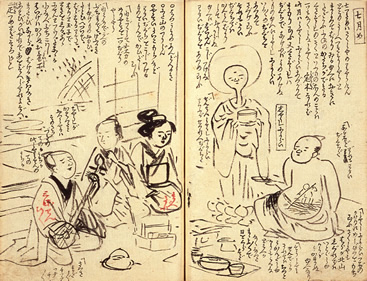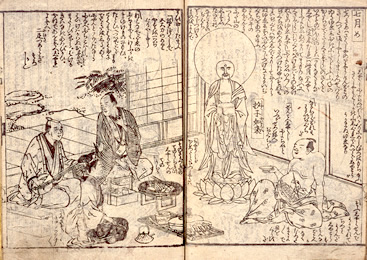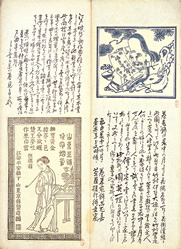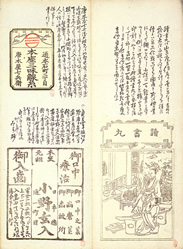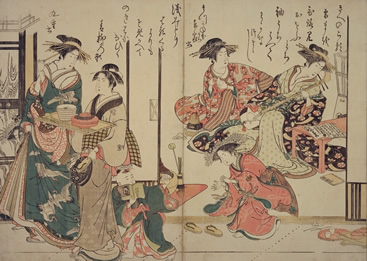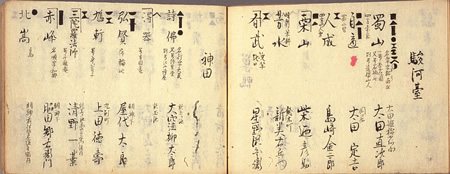These types of books are called ki-byoshi, a kind of illustrated novel for the public. This book depicts the hardship of writing a novel by regarding it as a process from pregnancy to delivery. The book No.50 is a draft, where the author also gives instructions to the illustrator.
The book No.51 is a published one printed by wood block. The compositions are almost the same as Kyoden's instructions.
Home > 2. Intellectual Exchange > Writings and Life of Novelists 2
50. Sakusha tainai totsuki no zu
- drafted by Santo Kyoden in the 4th year of the Kyowa Era (1804), 1 book, 17.5
 12.3cm <WA19-9>
12.3cm <WA19-9>
51. Sakusha tainai totsuki no zu
- 3 volumes, by Santo Kyoden, 3 books (bound in one volume), printed by Tsuruya Kiemon (of Edo) in the 4th year of the Kyowa Era (1804), 16.7
 12.5cm <WA19-9>
12.5cm <WA19-9>
50. Sakusha tainai totsuki no zu![]() "NDL Digital Collections"
"NDL Digital Collections"
51. Sakusha tainai totsuki no zu![]() "NDL Digital Collections"
"NDL Digital Collections"
52. Edo jidai meibutsu shu
- 1 book, made around the Meiji Era to the Taisho Era, 30.2
 11.2cm <
11.2cm < 8-3-2-1>
8-3-2-1>
Trademarks and ads in the Edo Period are collected and pasted on a white book. The photo partially shows the pipe and the medicine called "Dokusho-gan" sold at the Santo Kyoden's store. In the Edo Period, it was common that story writers had their main business and wrote stories in their spare time.
53. Yoshiwara keisei shin bijin awase jihitsu kagami
- by Kitao Masanobu, printed by Tsutaya Juzaburo in the 4th year of the Tenmei Era (1784) [as described in the preface], 1 book, 35.5
 24.7cm <WA32-6>
24.7cm <WA32-6>
Santo Kyoden also painted ukiyoe under the name of Kitao Masanobu. This picture book depicts Yoshiwara.
54. Shoka jinmei Edo hogaku wake
- copied in the 1st year of the Bunsei Era (1818), 1 book, 11.7
 17.1cm <
17.1cm < 18-20>
18-20>
This is a kind of "who's who" listing literary men living in Edo and categorized by area. Completed around 1817 or 1818. The persons whose works are exhibited here are included. This who's who was previously owned by Ota Nampo, with his notes inserted.


